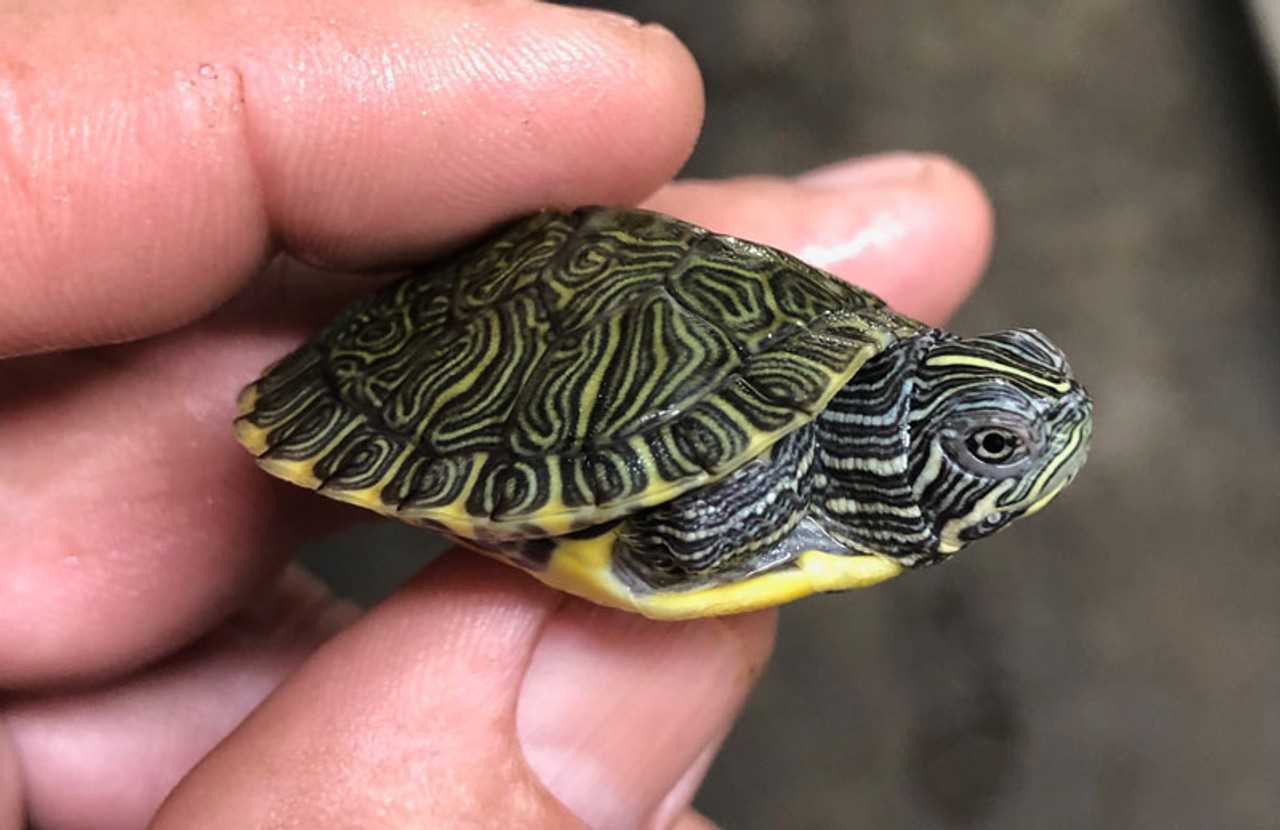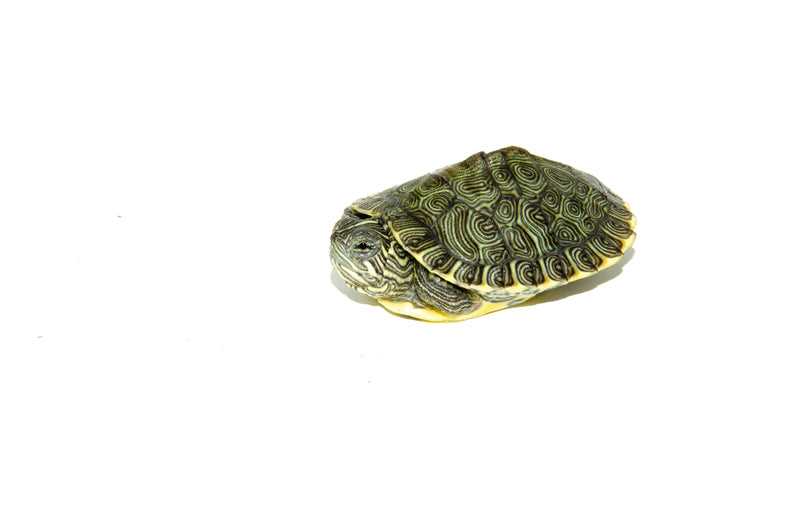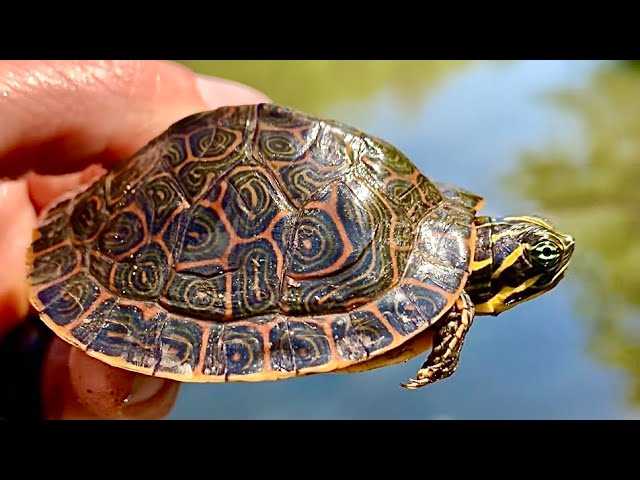Feeding the baby river cooter turtle is also an important aspect of its care. These turtles are omnivores, meaning they eat both plants and small insects. Their diet should consist of a variety of leafy greens, such as kale and dandelion greens, as well as small live or frozen prey like crickets and mealworms. It’s essential to provide a balanced diet to ensure their health and growth.
In addition to their care requirements, baby river cooter turtles have a few fascinating facts that make them even more intriguing. For example, they have a unique ability to bask in the sun to regulate their body temperature. They will often climb onto rocks or logs near the water’s edge to soak up the warmth of the sun.
Another interesting fact about baby river cooter turtles is that they are excellent swimmers. Their webbed feet and streamlined shell allow them to glide effortlessly through the water. They are also known for their ability to hold their breath for long periods, making them excellent divers.
Overall, caring for a baby river cooter turtle can be a rewarding experience. With the right habitat, diet, and attention to their unique needs, these turtles can thrive and bring joy to their owners for many years to come.
Natural Habitat of Baby River Cooter Turtles
The natural habitat of baby river cooter turtles consists of a combination of aquatic and terrestrial environments. They require access to water for swimming, feeding, and thermoregulation. The presence of aquatic vegetation, such as water lilies and duckweed, is important as it provides food and shelter for these turtles.
These turtles are often found in areas with slow-moving or still water, such as backwaters, marshes, and swamps. They prefer areas with abundant vegetation and ample hiding spots, such as fallen branches or submerged tree roots. The soft sandy or muddy bottoms of these habitats provide an ideal substrate for nesting.
Overall, the natural habitat of baby river cooter turtles is a diverse and dynamic ecosystem that provides them with the resources they need to survive and thrive.
Physical Characteristics of Baby River Cooter Turtles
One of the distinguishing features of baby river cooter turtles is their webbed feet. These webbed feet are specially adapted for swimming, allowing them to move through the water with ease. The webbing between their toes helps them to navigate through their natural habitat, which is mainly aquatic environments like rivers, streams, and ponds.
In addition to their webbed feet, baby river cooter turtles also have a long neck and a pointed snout. These features enable them to reach their food sources more easily and efficiently, as well as help them breathe while submerged in water.
Coloration
The coloration of baby river cooter turtles can vary. While some may have darker brown or olive shells, others may display a more vibrant pattern with darker spots or streaks. Their skin is usually dark, with variations of black, brown, or green. The combination of colors and patterns on their shells and skin make them fascinating to observe.
Shell Growth and Development
Senses
Baby river cooter turtles have well-developed senses that help them navigate and survive in their environment. Their sense of sight allows them to identify food sources and predators, while their sense of touch helps them explore their surroundings. These turtles also have a keen sense of smell, which they use to locate food and potential mates.
Diet and Feeding of Baby River Cooter Turtles

Proper diet and feeding are essential for the healthy growth and development of baby river cooter turtles. These turtles are omnivorous, which means they eat a combination of both plant and animal matter. Providing a varied diet is important to ensure they receive all the necessary nutrients.
In addition to plants, baby river cooter turtles also require a source of animal protein in their diet. This can be achieved through feeding them small aquatic invertebrates such as fish, shrimp, and insects. These can be purchased from pet stores or collected from natural sources, ensuring they are safe and free from pesticides or other harmful substances.
Feeding Schedule
It is recommended to feed baby river cooter turtles daily. Their small size and high metabolism require frequent meals to support their growth. Offer a variety of food items in each feeding session to ensure a balanced diet. On average, baby river cooter turtles should consume an amount of food equivalent to the size of their head each day.
Feeding Tips
Here are some additional tips to ensure proper diet and feeding for baby river cooter turtles:
- Monitor their eating habits and adjust the amount of food accordingly. Overfeeding can lead to obesity and other health issues, while underfeeding can result in stunted growth.
- Remove any uneaten food from the tank after feeding to maintain water quality and prevent bacterial growth.
- Consider the use of a separate feeding tank or area to make feeding easier and prevent food from scattering throughout the enclosure.
- Always provide clean, chlorine-free water for drinking and soaking. Encourage hydration by misting the enclosure regularly.
- Offering occasional treats such as freeze-dried shrimp or commercial turtle treats can provide enrichment and variety in their diet.
By following these guidelines for diet and feeding, you can ensure that your baby river cooter turtles receive the nutrition they need to thrive and lead a healthy life.
Tank Setup for Baby River Cooter Turtles
The first thing to consider is the size of the tank. Baby river cooter turtles need plenty of space to swim and explore, so a tank that is at least 20 gallons in size is recommended. As your turtle grows, you may need to upgrade to a larger tank to accommodate its increasing size.
In addition to the substrate, you should provide a variety of hiding spots and basking areas for your baby cooter turtle. You can use rocks, driftwood, or commercially available turtle docks to create these spaces. Having multiple hiding spots and basking areas will allow your turtle to regulate its body temperature and feel secure in its environment.
Lastly, you’ll need to provide appropriate lighting and heating for your baby river cooter turtle. Use a UVB light to provide the necessary ultraviolet rays for your turtle’s health and shell development. A basking light or lamp should also be provided to create a warm spot in the tank where your turtle can dry off and regulate its body temperature.
Overall, creating a suitable tank setup for your baby river cooter turtle involves providing enough space, the right substrate, hiding spots and basking areas, clean water, and proper lighting and heating. With the right environment, your baby turtle will thrive and grow into a healthy adult.
Temperature and Lighting Requirements for Baby River Cooter Turtles
Proper temperature and lighting are essential for the health and well-being of baby river cooter turtles. These turtles are ectothermic, which means they rely on their environment to regulate their body temperature.
UVB lighting is crucial for baby river cooter turtles as it helps them synthesize vitamin D3, which is necessary for calcium absorption. Without sufficient UVB lighting, these turtles may develop metabolic bone disease, which can lead to soft shells and skeletal deformities.
| Temperature | Lighting |
|---|---|
| 75-85 degrees Fahrenheit (24-29 degrees Celsius) | UVB lamp positioned 10-12 inches above the basking area |
Remember to provide a proper photoperiod, mimicking the natural light cycle. This means providing 10-12 hours of light during the day, followed by 10-12 hours of darkness at night.
By providing the baby river cooter turtle with the right temperature and lighting, you can ensure its proper growth and overall health.
Water Quality and Filtration for Baby River Cooter Turtles
Maintaining the proper water quality and filtration system is crucial for the health and well-being of baby river cooter turtles. These turtles require clean and well-filtered water to thrive in captivity.
1. Water Temperature: The ideal water temperature for baby river cooter turtles should be kept between 75-85°F (24-29°C). This can be achieved by using a reliable aquarium heater that is specifically designed for reptiles.
2. Water Depth: Baby river cooter turtles are aquatic creatures and therefore need a tank or enclosure with a sufficient water depth. A shallow water level of around 4-6 inches (10-15 cm) is suitable for these turtles, allowing them to swim, dive, and explore comfortably.
3. Water Filtration: An efficient filtration system is essential for maintaining clean and healthy water conditions for baby river cooter turtles. A good quality filter should be able to remove debris, waste, and harmful substances from the water, ensuring optimal water quality for the turtles.
4. Water Changes: Regular water changes are necessary to prevent the build-up of ammonia, nitrate, and other harmful substances in the tank. It is recommended to perform partial water changes of about 25% every week to maintain water quality.
5. Dechlorination: Tap water can contain chlorine and other chemicals that are harmful to turtles. It is crucial to dechlorinate the water before adding it to the tank. There are various dechlorination products available in pet stores that can be used to make tap water safe for the turtles.
6. Water Testing: Regularly testing the water parameters such as pH, ammonia, nitrite, and nitrate levels is important to ensure a healthy environment for baby river cooter turtles. Test kits can be purchased to monitor these parameters and maintain ideal conditions.
7. UVB Lighting: Baby river cooter turtles require UVB lighting to help with their calcium absorption. UVB rays are necessary for the turtles to synthesize Vitamin D3, which is essential for their bone health. A UVB light with a proper wavelength should be provided in the tank for about 10-12 hours a day.
By maintaining proper water quality and filtration, along with adequate UVB lighting, you can provide a suitable and thriving habitat for your baby river cooter turtles. Regular monitoring and care will help ensure their health and longevity.
Handling and Interaction with Baby River Cooter Turtles
Interacting with your baby river cooter turtle can be done through observation and providing enrichment in its tank. You can create a naturalistic environment with rocks, plants, and hiding spots for the turtle to explore and feel safe. Additionally, you can offer your turtle a variety of safe toys and objects to interact with, such as floating platforms or basking areas.
| Do’s | Don’ts |
|---|---|
|
|
By following these guidelines, you can ensure the well-being of your baby river cooter turtle while still providing them with a stimulating and enriching environment to thrive in.
Common Health Issues in Baby River Cooter Turtles
| Health Issue | Symptoms | Treatment |
|---|---|---|
| Respiratory Infections | Coughing, wheezing, nasal discharge, lethargy | Antibiotics prescribed by a veterinarian |
| Shell Rot | Soft or discolored shell, foul odor | Clean and disinfect the shell, improve water quality |
| Shell Pyramiding | Pyramid-shaped bulges on the shell | Correct diet and proper lighting |
| Vitamin Deficiencies | Soft shell, weak bones, poor growth | Supplement the diet with calcium and UVB lighting |
| Parasites | Weight loss, diarrhea, decreased appetite | Medication prescribed by a veterinarian |
| Eye Infections | Swollen or red eyes, discharge | Antibiotic eye drops or ointment |
Lifespan and Growth of Baby River Cooter Turtles
As baby River Cooter turtles grow, their size and lifespan evolve. These turtles have an average lifespan of 20 to 30 years, but with proper care, they can live even longer.
During the first few years of their life, baby River Cooter turtles experience rapid growth. They start as tiny hatchlings, measuring only around 1 inch in length. However, within a few years, they can reach sizes of 8 to 12 inches.
Proper nutrition plays a crucial role in the growth and development of baby River Cooter turtles. A well-balanced diet should consist of a mix of aquatic plants, such as water lettuce and water hyacinth, as well as commercial turtle pellets and occasional protein sources like insects and worms.
Regular veterinary check-ups are recommended to ensure that any potential health issues are addressed promptly to maximize the lifespan of baby River Cooter turtles.
Monitoring the growth and development of these turtles is not only fascinating but also important in ensuring their well-being. By providing a suitable environment and a proper diet, you can help your baby River Cooter turtle thrive and potentially enjoy a long and fulfilling life.
Fun Facts about Baby River Cooter Turtles

If you are fascinated by river turtles, especially the baby ones, then you are in for a treat. Baby river cooter turtles are adorable creatures that have some interesting facts associated with them. Here are some fun facts about baby river cooter turtles:
1. Size and Appearance

Baby river cooter turtles are small and cute, measuring only about 2 to 3 inches in length. They have a smooth and slightly domed shell, which is usually brown or olive in color. Their skin is dark green or brown, with yellow or light green markings.
2. Lifespan
Baby river cooter turtles have an impressive lifespan. On average, they can live up to 10 to 15 years if properly cared for. With the right environment and diet, some individuals have been known to live even longer.
3. Diet
4. Swimming Abilities
Baby river cooter turtles are excellent swimmers. With their webbed feet and streamlined shells, they are well-suited for their aquatic lifestyle. They can navigate through the water with ease, using their paddle-like limbs.
5. Temperature-Dependent Sex Determination
Like many reptiles, the gender of baby river cooter turtles is determined by the temperature at which their eggs are incubated. Higher temperatures during incubation produce more females, while lower temperatures result in more males.
6. Basking Habits

I’m Lena Adams—a product of an unconventional upbringing in the African wilderness. My father, a daring explorer of African wildlife, sparked my fascination with reptiles, a passion that intertwined with the tragic loss of my mother during an expedition, leaving an indelible mark on my life. Driven to understand the creatures that captivated my parents, I embarked on my journey, sharing insights about reptiles, frogs, and lizards on my website. Through my explorations and conservation efforts, I honour my family’s legacy while seeking connections—to the creatures, nature, and the mother whose presence I yearn to understand.
